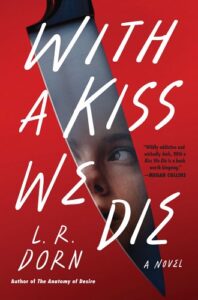“All the world loves a lover,” said someone (not Shakespeare, it turns out) expressing the universal appeal of romance and that enraptured state of attraction that often leads to procreation and the perpetuation of our species. And then there are those cases, fictional and non, where the lovers’ chemical infatuation leads to the inverse of reproduction: the murder of their fellow Homo sapiens. Yes, we’re talking about Mickey and Mallory in the Oliver Stone-Quentin Tarantino collaboration Natural Born Killers; Charles Starkweather and Caril Ann Fugate the real-life spree killers from the 1950s; Bonnie Parker and Clyde Barrow who shot to death policemen and civilians during the Depression; Karla Homolka and Paul Bernardo who abducted and murdered several young women in Canada during the 1980s. What are the twisted dynamics of a romantic affair that transforms partners in love into partners in homicide? The world may be in love with lovers, but the world abhors killers. Let’s look at the psychological, emotional, and narrative factors that go into portraying how falling in love can expose the sometimes thin line between romantic coupling and murderous complicity.
“Folie à deux is defined as shared psychotic disorder in leading medical and psychiatric journals. It’s a relatively rare clinical syndrome, and its characteristic feature is the transmission of delusions from an inducer, or primary, to another person, or secondary.”
So declares our podcasting crime journalist, Ryanna Raines, at the top of Episode 40 in our new crime novel, With a Kiss We Die. In extreme cases, folie à deux can lead a pair of intimates to plot and commit murder. We modeled our fictional crime story on a real-life double homicide that goes back to the mid-1980s. A retired married couple, Nancy and Derek Haysom, were found savagely stabbed to death at home in their quiet, family-friendly suburb of Boonsboro, Virginia. In this case, the adverb “savagely” is apt. Derek had been stabbed more than thirty times and Nancy at least six. Both had their throats slit and had been nearly decapitated. “To me, it was like a slaughterhouse,” said Chuck Reid, a Bedford County investigator who was one of the first detectives on the scene. There was no sign of breaking-and-entering. Nothing was stolen. In fact, there had been a place setting for a third person at the Haysom’s dining table. And there was evidence that whoever instigated this brutal bloodbath had rinsed off in the family shower before taking their leave. Six months later, Elizabeth, the Haysom’s 21-year-old daughter, and her boyfriend, 19-year-old Jens Soering, were in police custody and would eventually be charged with murdering her parents. Several investigators, journalists, and criminal psychology experts believed the root cause of their actions was the psychiatric syndrome known as folie à deux. The term comes from the French and translates in English as “madness for two.”
*
Stories of couples driven by passion and lust to commit crimes should be familiar to fans of hardboiled fiction and film noir. Lovers-turned-killers like Phyllis Dietrichson and Walter Neff, Matty Walker and Ned Racine, and Cora Smith and Frank Chambers have become enshrined in the darker veins of pop culture. “Double Indemnity,” the novella by James M. Cain that was adapted into a screenplay by Billy Wilder and Raymond Chandler, was based on the sensational real-life case of Ruth Snyder and Judd Gray whose hot-blooded extramarital affair led to the cold-blooded murder of Snyder’s husband. What was the stronger influence that drove Ruth into this murderous conspiracy, the love she felt for her new partner or the hate she felt for her husband? It’s a question the public found endlessly fascinating and helped spawn the “black widow” sub-genre in books and movies.
Then there are the spree killers, couples who commit multiple acts of indiscriminate violence during a compressed period of time. These lovers are often fueled by such extremes of emotional stimulation that their moral compasses go haywire. Charles Starkweather and Caril Ann Fugate were the real-life models for this type of folie à deux in the 1950s. During an era of conformity to conservative family values, their destructive path was seen as the darkest kind of social rebellion. Their troubled personas then morphed into the film characters Kit and Holly in Terence Malick’s Badlands (1973) and again into Mickey and Mallory in the Quentin Tarantino-written, Oliver Stone-directed Natural Born Killers (1994). The common throughline here is two young people for whom the combination of social alienation and an overdose of oxytocin (the “love hormone”) triggers a mutual homicidal rage.
Bonnie and Clyde are another subset of lovers whose romantic attraction is the spark that sets off a murderous combustion. The crime this pair set out to commit was robbing banks, not murdering people. Their first killings were committed during the act of robbery against the bank guards and lawmen who tried to stop them. The pair seemed to grow more desensitized to the act of killing as their number of victims rose and at the same time were spurred on by the tabloid infamy they achieved between the springs of 1932 and 1934. Their co-dependency descended to the point they made a pact to go down together in a hail of gunfire rather than be forced apart by the law. Whether they were actually caught in the grip of a shared psychosis is debatable, but their killings became increasingly ruthless and by the time they met their famously violent end the couple had left a trail of thirteen bodies across Texas and Louisiana.
Karla Homolka and Paul Bernardo fall into an even more problematic category—kidnap-torture-kill perpetrators. Dubbed in the press as the “Ken and Barbie Killers” because of their outward normality and physical attractiveness, this married couple committed acts together that pushed the boundaries of aberrant behavior. Their entanglement was dominated and propelled by intense sexual lust. The psycho-dynamics between this couple were so toxically complex that it’s hard for most of us to imagine. Or so repellent that our imaginations automatically reject going there in fear of beholding a darkness we can never un-behold. Certainly each had experienced their own psychological trauma by the time they fell into each other’s orbit. But the chemical reaction set off by their conjugation led to the most disturbing kinds of acts one human being – let alone two – can inflict on another.
Which brings us back to Elizabeth Haysom and Jens Soering, who authorities believed conceived, planned, and committed the hyper-violent murders of her parents. When we came upon this case through a documentary film “Killing for Love,” a nonfiction crime book “Beyond Reason: The True Story of a Shocking Double Murder, a Brilliant Virginia Socialite and a Deadly Psychotic Obsession,” and multiple true crime podcasts, we were baffled. How could these two intelligent, privileged, seemingly well-adjusted college students have committed such a horrific crime, not just of parricide but of double parricide? Writing With a Kiss We Die and creating the characters of Jordan De Carlo and Victoria Berne was a way to work through our bafflement by constructing an up-close look at “madness for two”—and how it manifests in a love story that takes a terribly wrong turn.
***


















